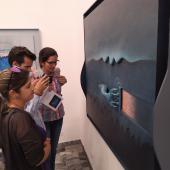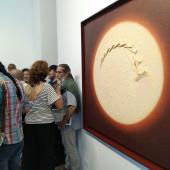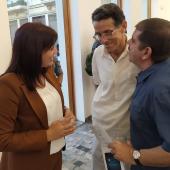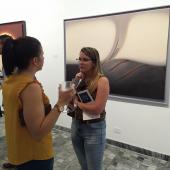Third Exhibition Counterpoint (January 17, 2020)
Description:
Words from the Contrapunto exhibition catalog, by curator David Mateo.
I once claimed that Juan Suárez Blanco had a reference work. But I said it perhaps in a too discreet, moderate way, when I was just beginning to discover the subterfuges of denotative discourse. Today I recognize that, since it was the visual production of an extremely modest creator and his interrelationship with an environment like that of the 1990s, devoted to histrionics, to the hasty search for supremacy, my arguments should have been more emphatic and generous.
I spoke of this referential value of Juan Suárez, relying on the production of objects that he had begun towards the end of the 1980s from recycling, and which he later maintained throughout the 1990s, when a type of installation work of combined technical resources, compact and integrative symbologies, and historical methodologies sustained by the formal sufficiency and the artisan artifices of certain trades was also beginning to be in vogue among young creators. He did not speak of debts or demand tributes, but simply suggested that we could look in other directions, towards other creators with similar formal and expressive intentions, beyond the capitalist scenario or a specific generational order. It would have been useful, and even vindictive, to investigate the "sculptural-pictorial" work of this artist, deeply imbued - as I have been able to investigate - with a working and knowledge-seeking side that is almost Renaissance, a side that - in my opinion - has once again planted its fertile seeds in some artists who began their work in the 1990s and 2000.
Although, in honor of the truth, I must say that I had a kind of indirect ally in that willingness to refer to the work of Juan Suarez Blanco: the researcher and art critic from Pinar del Río Jorge Luis Montesino who, although he did not make comparative statements on the subject, did emphasize through his texts and curatorships the sui generis condition of the minimalist volumetric production of Juan Suarez within the Cuban plastic context of that period (*)
I consider that the methodological and conceptual postulates that derived from those emblematic pieces by Juan Suárez Blanco, which did not have, as I already insinuated, all the prominence they deserved in the nineties, and which were conceived, moreover, in a place like Pinar del Río where traditional representative genres and variables swarmed, continued to move towards new expressive and tropical paths through two-dimensional painting of an abstract nature. A transition that may have seemed strange and forced to others, but not to me. I knew that in Juan Suárez Blanco's formation, painting occupied a preponderant place. He was, in that sense, an advantaged disciple. But I also understood that, in spite of the technical presumption, the meticulous minimalist process and the aesthetical notion that supported the pieces of the nineties, they -from an analysis of the whole- were inclined towards a strong tropical hermeticism, charged with a pattern often closed with iconographic and semiotic associations, which tempted from time to time the abstract dimension from the formal and the argumentative. It was, moreover, the two-dimensional logic that seemed to permeate the entire compositional process of the pieces, which imposed the terms in the manipulation and expansion of the volume, and conspired so that Juan Suárez would not pass definitively into three-dimensional practice.
With the exception of some landscape paintings that I had the opportunity to see in 2011 in one of the galleries of the Lombillo Palace, and which I interpreted as risky and unusual exercises of urban gravitation, in which the artist did not move away from drawing or tonal compaction either, I was satisfied to see that a good part of Juan Suárez Blanco's painting continued to be imbued with those representative dichotomies, or at least with the essential nuances that they embodied. I am basically referring to the operative counterpoint between containment and opening, segmentation and overflow.
The implementation of the parabolic discourse between the object, its functional symbolic charge and the human, civic condition, never completely disappeared from the pictorial equation; it simply reduced the selective inventory of objects; it condensed the dynamics or perspective with which they interacted within the structural area of the painting and its discursive body. The denotative weight of the artefact, which is perhaps now much more attached to life experiences as a creator and social entity, and the "counterproductive" imprint of its action (scratches, fragmentations, stains, cuts...) were entirely subordinated to the metaphorical noun of the scene, reducing to a minimum any possible operation of digression or perceptual and interpretative fragmentation; a noun that, even from the material point of view, ended up being much more aggressive, vibrant and - as he himself has recognised - sound.
The pictorial works he now exhibits in the show Contrapunto have taken this dramatism, this narrative tension of the parable, to a peak of exponentiality, always putting the technical skill and aesthetic sense of its representation first. On the one hand, it seems to lead them to question the solemnity and transcendence of the artistic act in itself, to the sufficiency or authority of the work created, and on the other hand, to a critical revisiting of the experience of faith or personal belief. I can't think of another speculation when I observe such suggestive scenes as that one where a simulated brush attacks all the apparent drawing and tonal uniformity of a plane; or when I see a creole chicharrera eroding the surface of the canvas to let another layer of a more strident, less peaceful color be glimpsed; or when I am in front of those paintings where the deep, irremediable cuts made by a sharp artifact manage to break that moment of ecstasy or alienation in front of a bucolic landscape or a supposed mythical emblem... There is no doubt that a maxim seems to gravitate around the artistic insinuations of Juan Suárez Blanco: the reality of art has been put in check once again by ordinary reality.
David Mateo
Havana, January 2020
Audiovisual material that reflects in summary what happened on the opening day of the exhibition Contrapunto, in Maxima gallery.










